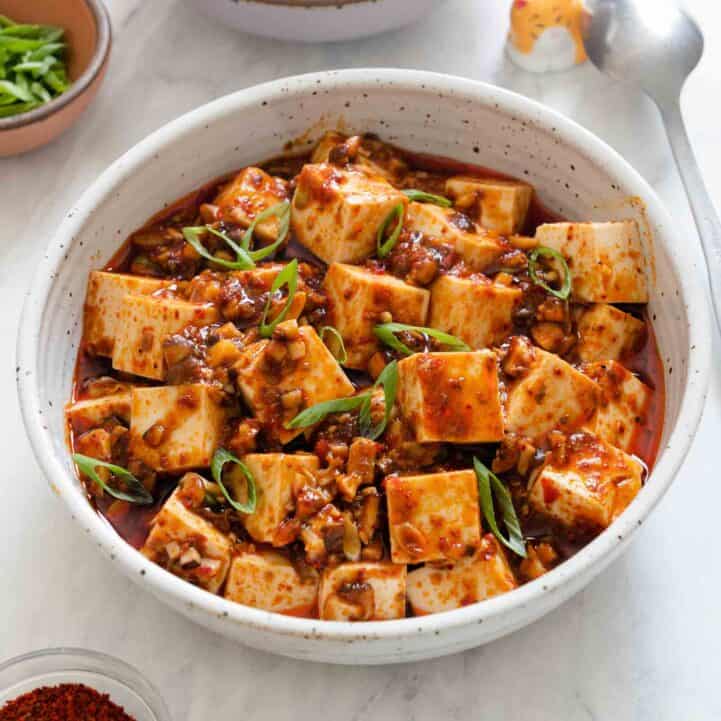
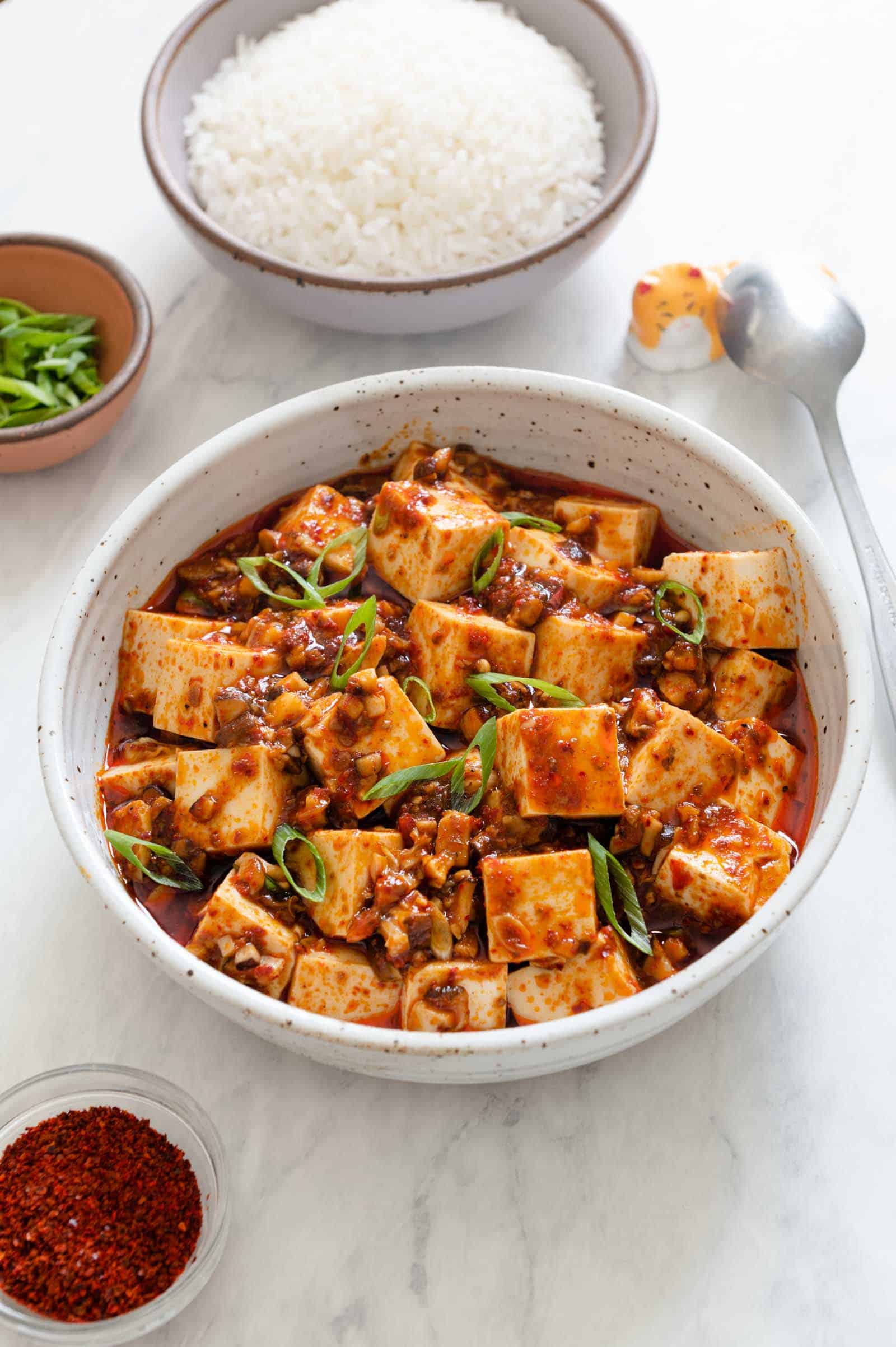
WHAT IS MAPO TOFU (麻婆豆腐)?
Mapo tofu (pronounced mapo doufu in Mandarin), originates from China’s Sichuan Province. It’s a dish made with pork mince and tofu bathed in a spicy sauce. According to legend, an old lady from Sichuan, who had pock marks on her face, was known for serving a delicious tofu dish. Over time, her special dish came to be known as 麻婆豆腐, literally “pock-marked old lady’s tofu.” You can read more about the history of the dish in Fuchsia Dunlop’s article on The Guardian.
WHAT IS MALA SPICE?
The key to good mapo tofu is the mala spice provided by red Sichuan peppercorns (大紅袍花椒). Mapo tofu was my introduction to the tongue numbing sensation of Sichuan peppercorns. When you bite into one of those peppercorns, you’ll feel a slight tingling on the tip of your tongue. In a few short moments, the tingling feeling transitions into a slight numbing sensation. It is a strangely addictive experience that is common when eating Sichuan cooking.
The phrase that describes the unique spice sensation associated with Sichuan cuisine is called mala (麻辣). In Chinese, “麻” means “numb” and “辣” means “spicy.” The combination of Sichuan peppercorns and chili flakes provide the distinctive mala flavor in Sichuan-style cooking.
HOW TO MAKE VEGAN MAPO TOFU
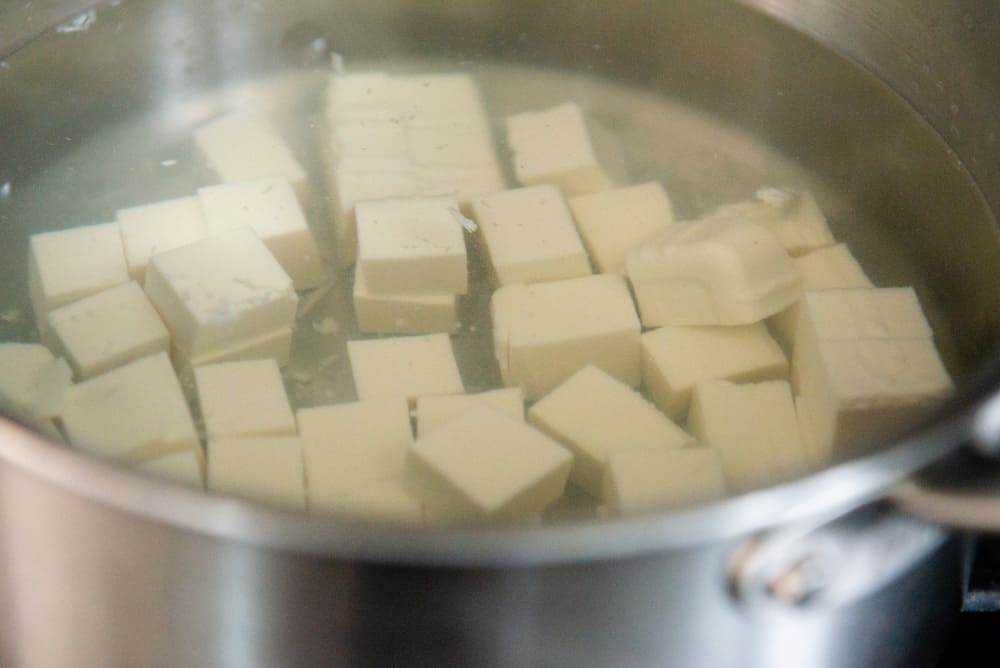
PREPARE THE TOFU
I prefer mapo tofu when made with softer, smoother tofu. If you are buying refrigerated tofu that comes in plastic rectangular containers, choose the variety labeled “silken” or “soft” tofu.
If you are buying small bricks of fresh tofu sold in bulk at an Asian supermarket, choose the tofu that is less firm. The tofu bricks are slightly firmer than silken tofu, but they work well for this recipe. Chop the tofu into 3/4-inch cubes.
One thing to note about cooking with silken tofu is that they crumble very easily. As a result, you won’t want to toss them in the wok too much. To heat the tofu thoroughly, boil some water with a bit of salt. Then, turn off the heat and soak the tofu cubes in hot water while you prepare the sauce.

A VEGAN VERSION
Typically, mapo tofu is made with pork mince for umami flavor. In this vegan mapo tofu recipe, I omitted the pork and used finely diced shiitake mushrooms instead. If you don’t like mushrooms, you can leave it out. Alternatively, you can substitute the mushrooms with 2/3 cup of finely diced sweet bell peppers or jicama for crunch.
Stir fry the shiitake mushrooms with 1 tablespoon of oil for about 2 minutes. Then, dish up the mushrooms.
INGREDIENTS FOR SAUCE

Doubanjiang (豆瓣醬): This is a Sichuan-style chili sauce made with fermented broad beans/fava beans. The sauce is quite salty, which is why I don’t add additional salt to the sauce. In a previous iteration of the recipe, I added another tablespoon of black bean and garlic sauce (蒜蓉豆豉醬). Having cooked this dish again over the past few years, I don’t find the addition necessary and makes the dish even more salty. That’s why I’ve omitted the sauce in this newer version.
You can find doubanjiang in Asian grocery stores, especially ones that sell Chinese ingredients. If you don’t have easy access to an Asian grocer, you can find it on Amazon (affiliate link) or Asian online stores like Yamibuy or Weee!

Red Sichuan Peppercorn: Measure out 3 to 4 teaspoons of the peppercorns and grind it with a mortar and pestle or with a spice grinder. If you’re using a mortar and pestle, you’ll find that the husks won’t break down entirely. Because this recipe uses a considerable amount of Sichuan peppercorns, the firm texture of the husks can get annoying as you eat the tofu.

I recommend sifting the ground peppercorns through a fine mesh to sift out the husks. Grind 3 teaspoons (or 1 tablespoon) of the peppercorns if you want some spicy tingle in the dish; grind 4 teaspoons if you want more.
If you use a spice grinder, I recommend grinding a few tablespoons of the peppercorns at once. I find grinders don’t work as well when you’re grinding very low quantities of something. Then, sift out the husks (yes, there’ll still be some). Finally, measure out 1 1/2 teaspoons of the sifted peppercorns for the dish; use 2 teaspoons if you want more spice.
Garlic & Ginger: I like using minced garlic and ginger for aromatic spice. The recipe uses 1 tablespoon of minced ginger. If you want a more spicy dish, you can add 2 to 3 more teaspoons of minced ginger.
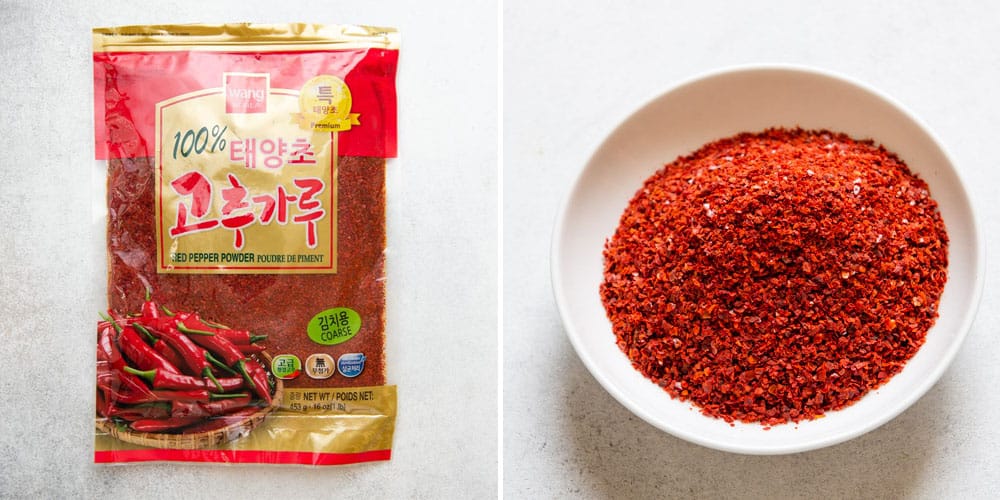
Chili Flakes: Usually, mapo tofu recipes use Chinese chili flakes. In this recipe, I add gochugaru, Korean red pepper flakes, because I love their lightly smoky flavor and the bright red color they add to the dish. The spice level of gochugaru is generally pretty mild. Feel free to use less if you are more spice averse.
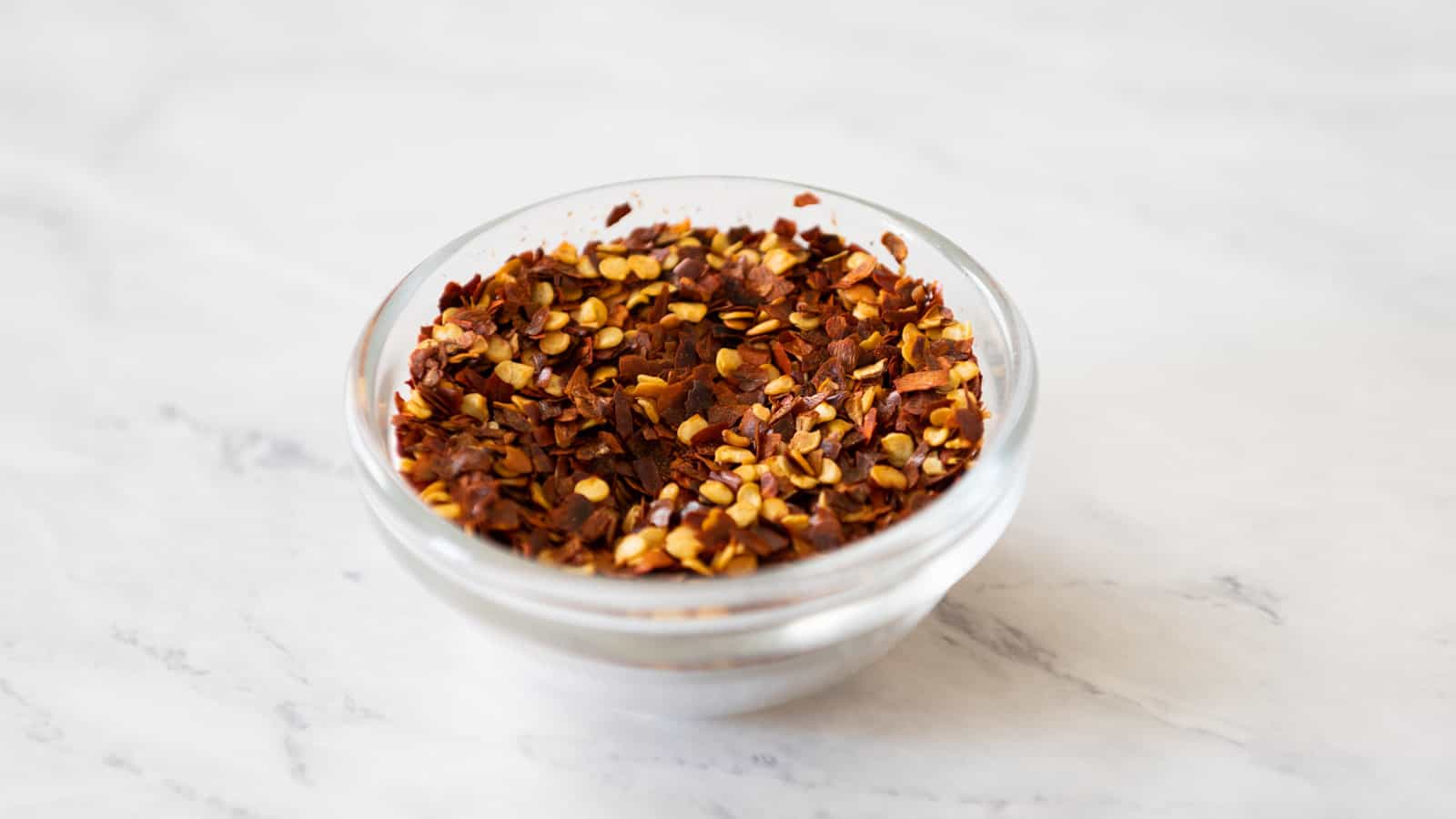
Substitutions for Gochugaru: You can use chili flakes like the ones in the photo above. These chili flakes with seeds can be much spicier than gochugaru. If you taste some of it and detect a strong heat at the tip of your tongue, I’d start with 3/4 teaspoon of the chili flakes. Add more if you want more spice.
Sugar: I add a little sugar in the sauce to balance the salty flavor of the doubanjiang.
Cornstarch slurry: You’ll also need 1/2 cup of water mixed with 1 teaspoon of cornstarch (the cornstarch acts as a thickener). The cornstarch can be replaced with tapioca starch.
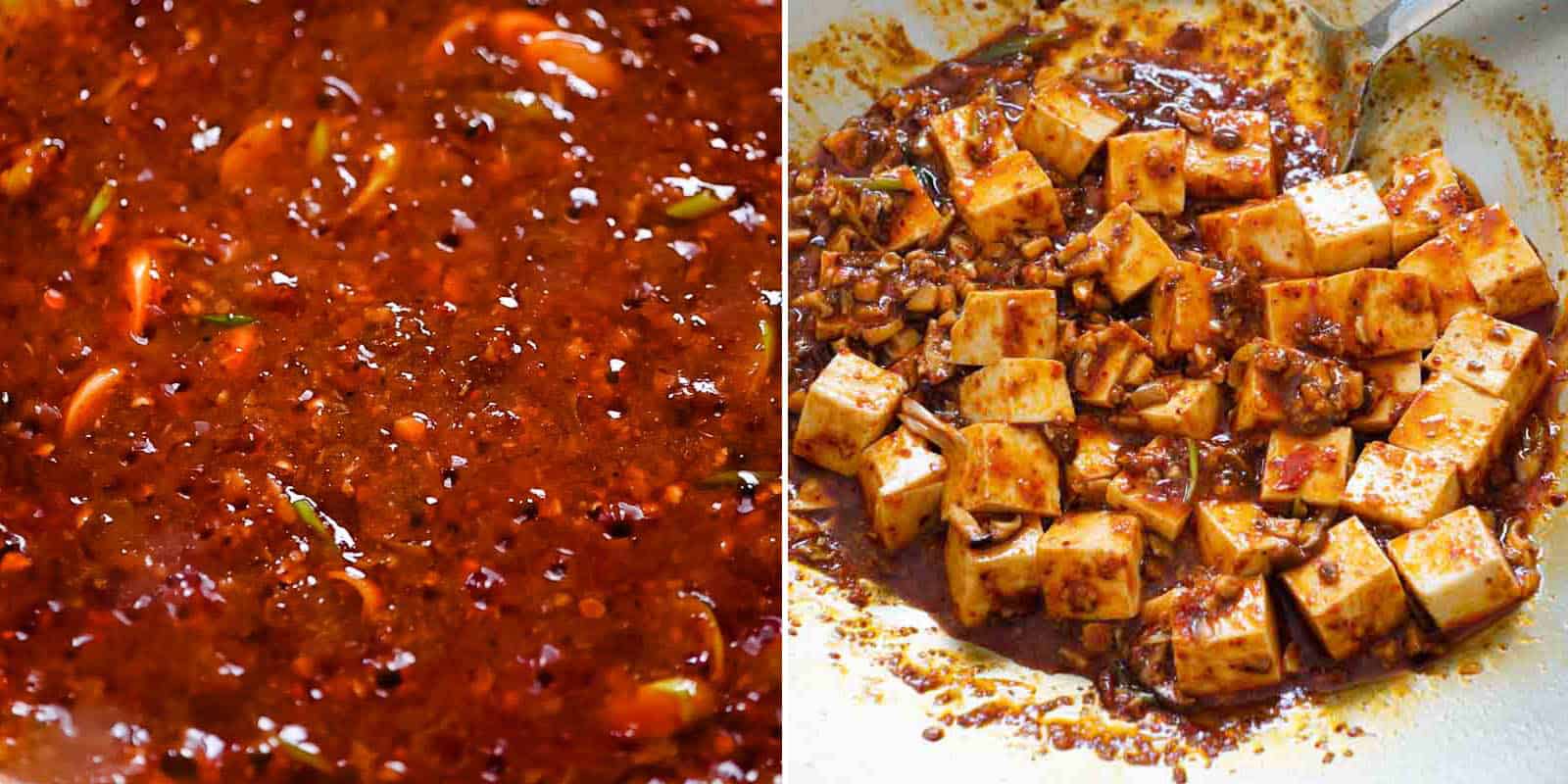
PREPARE THE SAUCE
Heat 2 tablespoons of oil on medium heat. Next, add the garlic and ginger and sauté for 30 seconds. Then, add the doubanjiang and sauté for another 30 seconds. Add the ground Sichuan peppercorn, gochugaru (or chili flakes), and sugar and stir together. Finally, add the cornstarch slurry and simmer the sauce for 2 to 3 minutes.
In this recipe, I slice a stalk of scallions for garnish. I use the dark green parts as garnish at the end, and I add the white and light green parts to the sauce as it simmers.
MIX THE SAUCE WITH MUSHROOMS & TOFU
Add the sautéed mushrooms the wok. Using a skimmer or a slotted spoon, transfer the warmed tofu to the wok as well. Then, carefully toss everything together. The tofu is very delicate and can break apart easily, so be careful.
Serve the mapo tofu in a bowl. Drizzle the tofu with a bit of sesame oil and garnish with the sliced scallions.

WHAT TO SERVE WITH MAPO TOFU
- Rice! Try Jasmine Rice, Brown Rice, or Coconut Rice
- Chinese Smashed Cucumber Salad
- Roasted Asparagus
- Chinese Garlic Green Beans
- Green Papaya Salad

Vegan Mapo Tofu (素食麻婆豆腐)
I’ve also added diced shiitake mushrooms to give the dish more substance. If you are not a fan of mushrooms, leave them out or use a 2/3 cup of finely diced bell peppers or even jicama if you want some crunch.
Ingredients
Tofu
- 1 pound (455g) soft or silken tofu (see note 1)
- 8 cups (1.9L) water
- 2 teaspoons (12g) table or sea salt
Mushrooms
- 1 tablespoon neutral oil (vegetable, canola, safflower, etc.)
- 1 cup (65g) finely diced shiitake mushrooms
Sauce
- 3 to 4 teaspoons Sichuan peppercorn depending on desired spice level
- 1 teaspoon (12g) cornstarch or tapioca starch
- 1/2 cup (235ml) water
- 2 tablespoons neutral oil (vegetable, canola, safflower, etc.)
- 2 tablespoons (15g) minced garlic
- 1 tablespoon (7g) minced ginger
- 2 tablespoons (40g) doubanjiang (see note 2)
- 1 1/2 tablespoons (10g) gochugaru (see note see note 3 for substitutions)
- 1/2 teaspoon (6g) sugar
- 1 stalk of scallions sliced, lighter pieces and dark green pieces separated
- drizzle of sesame oil
Instructions
Prepare the Tofu
-
Drain the block of tofu and remove it from the package. Cut the tofu into 3/4-inch cubes.
-
Add 8 cups of water and 2 teaspoons salt to a saucepan and bring it to boil. Remove the saucepan from heat.
-
Using a skimmer or slotted spoon, carefully lower the tofu cubes into the hot water. Let the tofu sit in hot water as you prepare the sauce.
Cook Mushrooms
-
Heat 1 tablespoon of oil in a wok over medium heat. Add the mushrooms and cook for about 2 minutes, stirring frequently.
-
Transfer the mushrooms to a bowl and turn off the heat.
Prepare the Sauce
-
Grind the Sichuan peppercorns with a mortar and pestle or spice grinder. Sift the ground peppercorns through a fine mesh to sift out the tough husks. Discard the tough husks (see note 4).
-
Add ½ cup of water and 1 teaspoon cornstarch to a small bowl and stir to combine. Set it aside.
-
Heat 2 tablespoons of oil on medium-high heat. Add the garlic and ginger and sauté for 30 seconds. Then, add the doubanjiang and sauté for another 30 seconds. Add the ground Sichuan peppercorn, gochugaru (or other chili flakes), and sugar and stir together. Finally, give the cornstarch slurry a stir again and add to the wok (see note 5). Add the white and light green parts of the scallion. Let the sauce simmer for 2 minutes.
Mix Sauce with Mushrooms & Tofu
-
Add the sautéed mushrooms to the wok. Using a skimmer or a slotted spoon, transfer the warmed tofu to the wok as well. Then, carefully toss everything together. The tofu is very delicate and can break apart easily, so be careful.
-
Transfer the mapo tofu to a serving bowl.
-
Drizzle a tiny bit of sesame oil over the tofu. Garnish the to with the dark green parts of the scallion. Serve with jasmine rice or brown rice.
Notes
- Some soft or silken tofu comes in 14-ounce packages, which also works for this recipe.
- You can find doubanjiang in Asian grocery stores, especially ones that sell Chinese ingredients. If you don’t have easy access to an Asian grocer, you can find it on Amazon or Asian online stores like Yamibuy or Weee! You can use any leftover doubanjiang in these recipes: Spicy Eggplant Stir Fry, Spicy Peanut Noodles.
- I prefer using gochugaru because it gives the sauce a nice red color and a subtle smoky flavor. You can use Chinese-style chili flakes or even red pepper flakes that you can find in grocery stores. Note that different chili flakes vary in their level of spice! If you’re using a very mildly spiced chili flake, use 1 tablespoon and add more if desired. Chili flakes form the supermarket that are sold with the seeds tend to be spicier. If you’re using that type of chili flake or any spicy chili flake, start with 3/4 teaspoon of the flakes and add more if you want more spice.
- In a previous iteration of the recipe, I didn’t sift out the husks of the peppercorns. A few of my friends told me they didn’t like the tough texture of the husks. That’s why I’ve added the step of sifting the ground peppercorns. When you sift out the husks, you lose about half of the volume of the peppercorns. That’s why in this new version of the recipe, I’m using slightly more Sichuan peppercorns to start.
- Cornstarch settles at the bottom very easily. That’s why you should stir the cornstarch before adding to the wok.
Nutrition
Note: This post was first published in October 2019. I have updated the post with more photos and altered the recipe, which I explain further in the recipe headnote.
The post Vegan Mapo Tofu (麻婆豆腐) appeared first on Healthy Nibbles by Lisa Lin.


